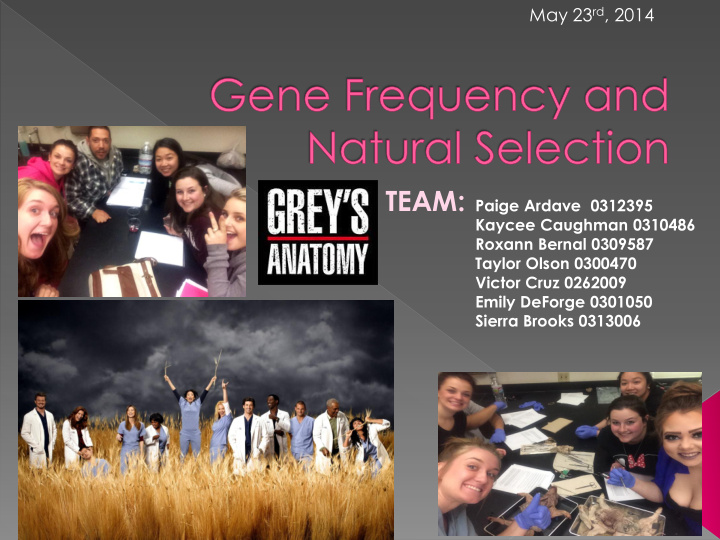



May 23 rd , 2014 TEAM: Paige Ardave 0312395 Kaycee Caughman 0310486 Roxann Bernal 0309587 Taylor Olson 0300470 Victor Cruz 0262009 Emily DeForge 0301050 Sierra Brooks 0313006
Gene Frequency : the ratio of a particular allele to the total of all other alleles of the same gene in a given population Mutation is Gene frequency -Mutation is a weak force for changing allele frequencies, but is a strong force for introducing new alleles. Natural Selection : the process whereby organisms better adapted to their environment tend to survive and produce more offspring. The theory of its action was first fully expounded by Charles Darwin and is now believed to be the main process that brings about evolution. “Survival of the fittest”
Methods (Natural Selection) • Select 7 dots of colored dots, 40 each color • Place 20 of each set on mat (mix them up if you prefer) • Predator from another group comes over and picks dots off of your environment for one minute • Next count the survivors and calculate the surviving couples • For the next generation add in the amount of off spring (surviving pairs x 2) along with your survivors. • Second generation predator uses two hands for one minute to pick dots. • The third generation there will be two predators using one hand each to pick dots. • During fourth generation you will change the environment mat to a new environment scheme • For example ours went from the Halloween mat to the green shoe environment • Make sure to be careful when transferring all dot from the environments so you can receive accurate information/data • The fourth generation will have two predators that will use both hands for one minute • The fifth generation will have a natural disaster occur. • Make sure that along the way you are keeping track of your traits to make sure they have not been killed off and that you are adding the proper amount of dots each time to the environment
Methods (Gene Frequency) • Beads were randomly selected for 6 successive filial generations. • Each successive generation was artificially decreased in order to introduce randomness. • We killed off the ww organism in order to show it being decreased. • The black beads were added/killing off in order to represent the disease spreading rapidly within the organism/specimen
Results for Gene Frequency
Results for Natural Selection Generations 1,2 and 3: Generations 4,5, and 6 with environment changes:
Natural Selection Methods This was our first environment, Generations 1-3 Purple background with colorful Halloween pictures. Colors: Purple, green, yellow, orange and black This was our second environment, Generations 3-6 Yellow/Lime green background with colorful halloween pictures. Colors: Green, yellow, purple, pink, orange,black, dark and light blue
Gene Frequency methods Recessive white beads, ww Dominant red beads, RR Recessive and dominant beads mixed in with the mutation, Black beads BB
Gene Frequency vs. Natural Selection Negative results from the environment due to predators Negative Selection results based on homozygous recessive genes
Gene Frequency with mutation This a mutation bar graph in percentages. BB were the black beads, which were the mutation. In the first generation the mutation was very small, only at about 4%. Through each generation the mutation escalates all the way to 32% in the fifth generation. We ran out of time to complete the 6th generation, but my guess is that the mutation would have increased about 5%. As you can see, as the trait BB increases, the other traits decrease further and further in the next generation.
Gene frequency proves that recessive genes die off and are/or less present whereas dominant genes are stronger for future generations. Natural selection proves that the species itself, and its tactfulness and ability to adapt to new environments are a big part of survival but predator and natural occurrences are equal factors. The more aggressive the predator was, the quicker the different species were picked off, however when the natural disasters occurred, both the species and the predators were affected. In natural selection, survival of the fittest is essential, the strong genes are the ones that survive and are passed on through generations more present in future generations
Recommend
More recommend